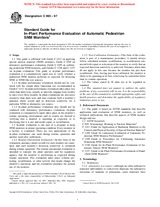Potřebujeme váš souhlas k využití jednotlivých dat, aby se vám mimo jiné mohly ukazovat informace týkající se vašich zájmů. Souhlas udělíte kliknutím na tlačítko „OK“.
ASTM C993-97
Standard Guide for In-Plant Performance Evaluation of Automatic Pedestrian SNM Monitors
Automaticky přeložený název:
Standardní Průvodce pro In- Plant Performance Evaluation of Automatic Pěší SNM Monitory
NORMA vydána dne 10.5.1997
Informace o normě:
Označení normy: ASTM C993-97
Poznámka: NEPLATNÁ
Datum vydání normy: 10.5.1997
Kód zboží: NS-16012
Počet stran: 8
Přibližná hmotnost: 24 g (0.05 liber)
Země: Americká technická norma
Kategorie: Technické normy ASTM
Anotace textu normy ASTM C993-97 :
Keywords:
gamma radiation, material control and accountability, neutron radiation, nuclear materials management, radiation detectors, radiation monitors, safeguards, security
Doplňující informace
| 1. Scope | ||||||||||||
|
1.1 This guide is affiliated with Guide C1112 on special nuclear material (SNM) monitors, Guide C1169 on laboratory performance evaluation, and Guide C1189 on calibrating pedestrian SNM monitors. This guide to in-plant performance evaluation is a comparatively rapid way to verify whether a pedestrian SNM monitor performs as expected for detecting SNM or SNM-like test sources. 1.1.1 In-plant performance evaluation should not be confused with the simple daily functional test recommended in Guide C1112. In-plant performance evaluation takes place less often than daily tests, usually at intervals ranging from weekly to once every three months. In-plant evaluations are also more extensive than daily tests and may examine both a monitor's nuisance alarm record and its detection sensitivity for a particular SNM or alternative test source. 1.1.2 In-plant performance evaluation also should not be confused with laboratory performance evaluation. In-plant evaluation is comparatively rapid, takes place in the monitor's routine operating environment, and its results are limited to verifying that a monitor is operating as expected, or to disclosing that it is not and needs repair or recalibration. 1.2 In-plant evaluation is one part of a program to keep SNM monitors in proper operating condition. Every monitor in a facility is evaluated. There are two applications of the in-plant evaluation: one used during routine operation and another used after calibration. 1.2.1 Routine Operational Evaluation -In this form of the evaluation, nuisance alarm records for each monitor are examined, and each monitor's detection sensitivity is estimated during routine operation. The routine operational evaluation is intended to reassure the plant operator, and his regulatory agency, that the monitor is performing as expected during routine operation. This evaluation takes place without pretesting, recalibration, or other activity that might change the monitor's operation, and the evaluation simulates the normal use of the monitor. 1.2.2 Post-Calibration Evaluation -This form of the evaluation is part of a maintenance procedure; it should always follow scheduled monitor recalibration, or recalibration connected with repair or relocation of the monitor, to verify that an expected detection sensitivity is achieved. Nuisance alarm data do not apply in this case because the monitor has just been recalibrated. Also, having just been calibrated, the monitor is likely to be operating at its best, which may be somewhat better than its routine operation. 1.3 The values stated in SI units are to be regarded as standard. 1.4 This standard does not purport to address the safety problems, if any, associated with its use. It is the responsibility of the user of this standard to establish appropriate safety and health practices and determine the applicability of regulatory limitations prior to use. |
||||||||||||
| 2. Referenced Documents | ||||||||||||
|




 Cookies
Cookies
